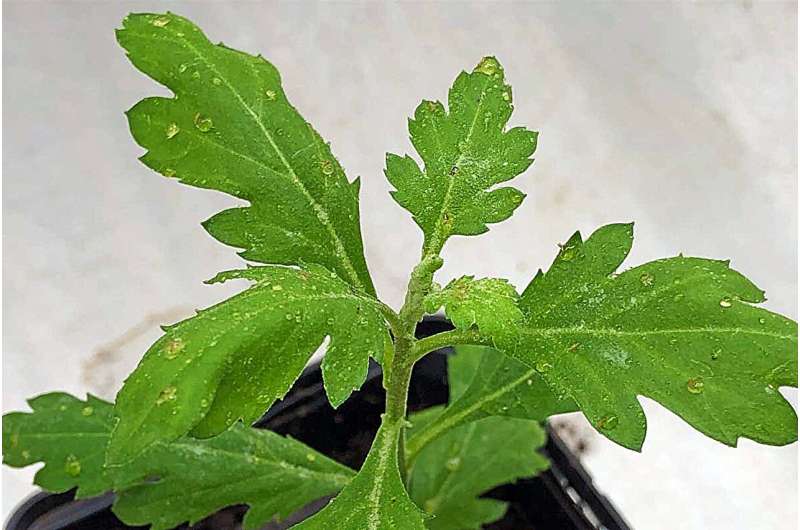This article has been reviewed according to Science X's editorial process and policies. Editors have highlighted the following attributes while ensuring the content's credibility:
fact-checked
peer-reviewed publication
trusted source
proofread
Scientists develop sticky pesticide to combat pest insects

Researchers from Wageningen University & Research (WUR) and Leiden University have engineered a biological barrier that protects plants from diseases and pests. It concerns a sticky substance that is sprayed on leaves, to which pests stick.
The researchers hope that this insect glue will help to reduce the use of toxic chemical pesticides. They published their findings in the Proceedings of the National Academy of Sciences.
In February, the European Commission withdrew its proposal to halve the use of chemical pesticides. However, the goal of reducing their use remains due to the harmful effects of these pesticides on human, animal and environmental health.
In the search for alternatives, scientists from WUR and Leiden University turned to nature for inspiration. "The carnivorous sundew plant has so-called glandular hairs that secrete a sticky substance to catch insects," says Thomas Kodger, Associate Professor of Physical Chemistry and Soft Matter. "We wanted to mimic this to protect our plants and crops in a natural way."
Targeted trap
The researchers succeeded in their endeavor. They transformed vegetable rice oil into a yellow, sticky substance by blowing air over it and grinding it into small particles using a laboratory blender. This results in beads of about one millimeter in diameter that are as sticky as duct tape. The size matches one of the common pest insect: thrips. By catching these insects, plants stay healthier and are less likely to become infected with fungi that the thrips carry with them.
So far, the researchers mainly focused on this type of pest, but the insect glue may also work against other pests, such as the Suzuki fruit fly that currently threatens cherry cultivation. At the same time, the drops are small enough that beneficial insects, such as pollinators, do not get stuck.
Unlike chemical pesticides, insects are unlikely to develop resistance against this adhesive, Kodger thinks. "Insects have already evolved so that they avoid adhesion, for example through hairs on their body and a bumpy surface," he explains. "Increasing their body size remains one of the few escape methods from this sticky trap." That is not nearly as easy as developing tolerance to a chemical substance. If it happens at all, it takes many generations and only happens if the insect glue is used on a large scale.
As (un)healthy as frying oil
After application, the sticky substance remains on the leaves for three months and cannot be washed off by rain. That is long enough to control pests until harvest. By spraying the insect glue on crops before the fruits develop, farmers minimize the chance of the pesticide getting onto the food. However, contact with food cannot be ruled out.
"The advantage of our pesticide over chemical pesticides is that you can see the small, yellow drops," says Kodger. "You can wash it off with water and dish soap." If you do ingest some of it, it is probably not harmful. As it is derived from vegetable oil, Kodger expects it to be no more harmful than frying fat, but scientists still need to investigate how (un)healthy it is exactly.
In the future, farmers may spray the sticky pesticide on their fields. This can be done using existing chemical sprayers. A special additive in the mixture ensures that the beads do not stick to each other or the machine.
Nevertheless, researchers must assess the environmental impact. "We rather not dump large amounts of cooking oil on the fields," says Kodger. In the coming years they will therefore study how quickly the oil degrades in soil.
Confident in their sustainable pesticide, Wageningen and Leiden researchers plan to launch a spin-off company to further develop and market this innovation. They intend to utilize various waste oils based on availability, adapting the process accordingly.
Kodger is enthusiastic about the company. "It is rewarding to witness our idea potentially changing the world within my lifetime." The company aims to start up by the end of this year.
More information: Ralph van Zwieten et al, Mimicking natural deterrent strategies in plants using adhesive spheres, Proceedings of the National Academy of Sciences (2024). DOI: 10.1073/pnas.2321565121
Journal information: Proceedings of the National Academy of Sciences
Provided by Wageningen University




















